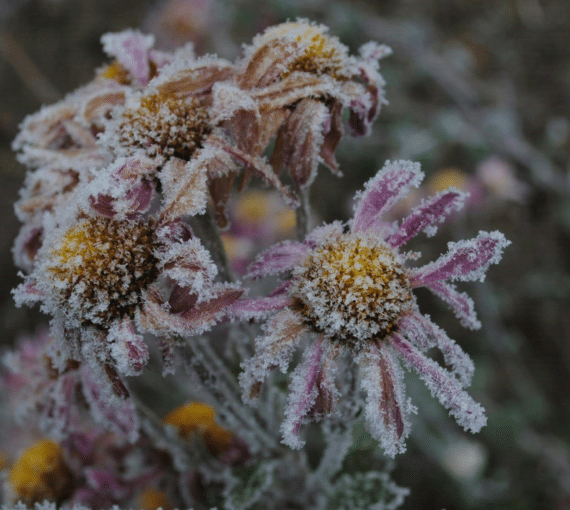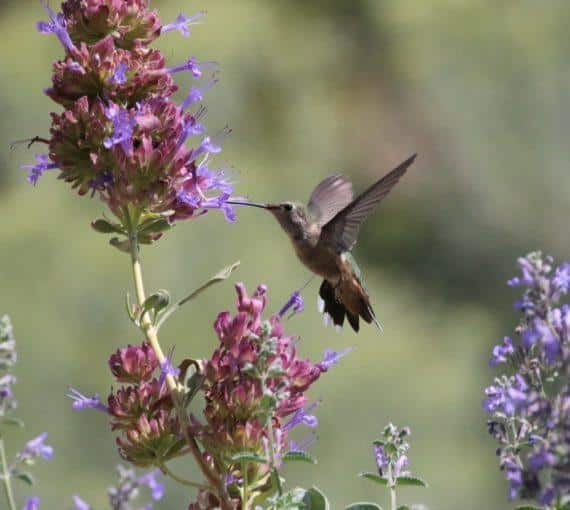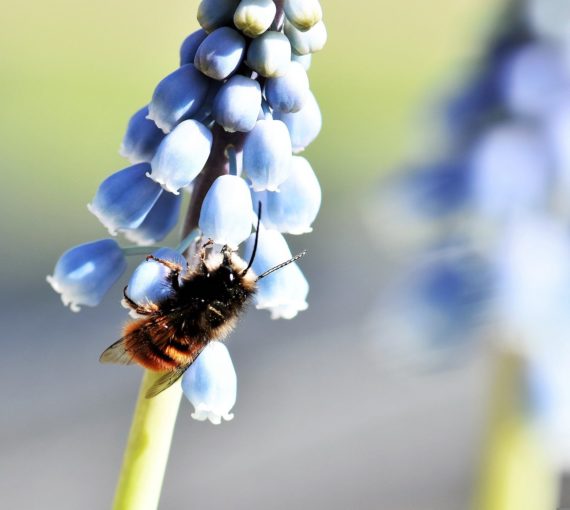
Ever noticed a line of little holes in your yard or lawn? You probably have ground-nesting bees. Keep your yard messy to help these pollinators thrive!
Have you helped pollinators, perhaps by planting a welcoming butterfly garden, not using harmful pesticides or getting your yard off grass? Here’s another thing you can do: keep a “messy” yard (in every season)!
Supporting pollinators in spring and summer
Transform your yard into a pollinator paradise in the warmer seasons. The secret? Keep it untidy.
Bees thrive in a messy yard. Most species are solitary and nest in the ground. Have you noticed a line of little holes in your yard or lawn, about six millimetres (1/4 inch) in diameter? You probably have ground-nesting bees, such as mining bees and some bumblebees.
How to help mining bees
Unlike honeybees, mining bees are solitary and don’t form large, socially organized nests. Their ideal nesting sites are exposed, well-drained soils with little vegetation. Mining bees are not aggressive and rarely, if ever, sting.
Besides pollinating wild plants and food plants like tomatoes and blueberries, bees that nest in the ground also benefit your garden by:
- Improving soil quality
- Increasing water movement around plant roots
- Mixing up soil nutrients
Here’s how to help them do their work…
Let herbs and veggies flower
Besides being a great way to witness a plant’s full life cycle, you can sit back and watch pollinators at work!
Collect twigs
Bundle them up and leave them in dry, sunny spots outside for bee nesting habitat. Brush piles and dead or dying trees also make great homes for pollinators.
Leave a patch of ground bare
Leave a small space dry, uncultivated and unmulched. About 70 per cent of Canada’s native bees nest underground.
Offer a source of water
Some pollinators — and all bees — also need muddy patches or another source of water and stones to perch on.

Create a wild bee sanctuary in five steps!
Wild bees need help. Many populations are declining due to habitat loss, disease and pesticide poisoning. Create a habitat to support them.
How to help bumblebees
Learn how to spot a bumblebee nest! There are three kinds of bumblebees, those that:
- Nest underground. Underground bumblebee species nest in abandoned mouse holes, under garden sheds and in compost heaps.
- Nest at ground level. Ground-dwelling bumblebees will also nest in a compost pile — some love the heat.
- Nest above ground. Above ground bumblebees might move into a birdhouse you didn’t clean out! They also make nests in thick grass and in tree cavities.
If your yard has dry, dark areas, it’s likely home to a few types of bumblebees that prefer these conditions.

How to tell bees from wasps and flies
It’s important to know the difference between bees, wasps and flies. The vast majority of insects in Canada are harmless, even beneficial. They’re often pollinators, critical in the production of many crops and essential in creating and preserving biodiversity.
Supporting pollinators in fall and winter
Creating a habitable pollinator sanctuary isn’t limited to spring and summer. You can start your “messy” yard practices in fall and continue into winter.
Plant late bloomers
As fall comes around, food sources become harder to come by. Pollinators have to search farther and wider for food. But with a little planning and dedication, you can make your yard a fall feast by including late-blooming native plants. Goldenrod and asters are examples of late-blooming plants native to many regions in Canada. Check what ecoregion you live in and find out what native plant species bloom late into the fall.
You can also plant during the fall to prepare for next year. Some pollinator-supporting species, such as milkweed, are best planted in the fall so they can undergo cold stratification. Cold stratification simulates the natural process by exposing seeds to a cool, moist environment. It breaks the seed’s dormancy and increases its ability to germinate in spring.
Leave the leaves
Brown, dead leaves are Earth’s insect nurseries. They’re home to butterfly larvae and shelter insects, microbes and worms.
So… let your rake collect dust. Raking yards has become a habitual gardening practice that disrupts critical habitat for overwintering pollinators. Unlike the monarch butterfly — a species well-known for migrating great distances from Canada to Mexico to flee the cold — many insects are at home up north and endure the cold.
Rocks and woody debris, such as old logs, tree stumps or loose bark, also provide space to hibernate for countless invertebrate species. Native pollinators, such as leafcutter bees and sweat bees, will nest in abandoned wood-boring beetle burrows. Leaving plant litter in your green space can increase backyard biodiversity and boost pollinator communities that will support your garden in the spring.
If you’re worried that fall leaves matted down by snow or rain will negatively impact your perennials, fear not! A thick layer of leaves provides added insulation against bitter cold weather and can protect newly planted perennials when frost-heave may expose tender roots. Once the weather warms and sheltered pollinators have emerged to start foraging, compost your yard waste.
Bonus: Leaf and mulch piles attract beneficial insects such as lady beetles, which will be ready to protect your garden from aphids when spring arrives!
If your neighbours make a fuss about the “mess,” be sure to let them know that your motivation is to make your yard more habitable for pollinators and talk to them about the importance of being a pollinator protector. Maybe they’ll join you!

Support overwintering pollinators in your garden
Winterize your garden with year-round pollinators in mind. Leave key plants and natural materials in place and/or winter sow native seeds. You’ll create a vibrant, ecologically beneficial winter pollinator haven and help your garden thrive in spring.
If you can’t leave all your leaves where they fall, use your leaves in other beneficial ways…
Remember: DO rake leaves out of sewers and drainage pathways.
Mulch leaves in planter beds
Does your homeowner’s association have something against leaves? Rake ’em off the lawn and into planter beds.
Mulch leaves on your lawn
Use a mower to mulch leaves on the lawn and improve its health by suppressing weeds and fertilizing the soil.
Collect browns to compost
Balance “greens” with “browns.” Store leaves in a bin and add them to your backyard composter throughout the winter months.
Craft with leaves
Have children collect their favourite leaves in your yard and neighbourhood and try your hand at nature weaving.



